What a colourful delight! Topped with sprinkles, these Sicilian cuddura each nest an egg ready to celebrate Easter! These traditional Italian Easter Cookies are as much fun to make as they are to eat.
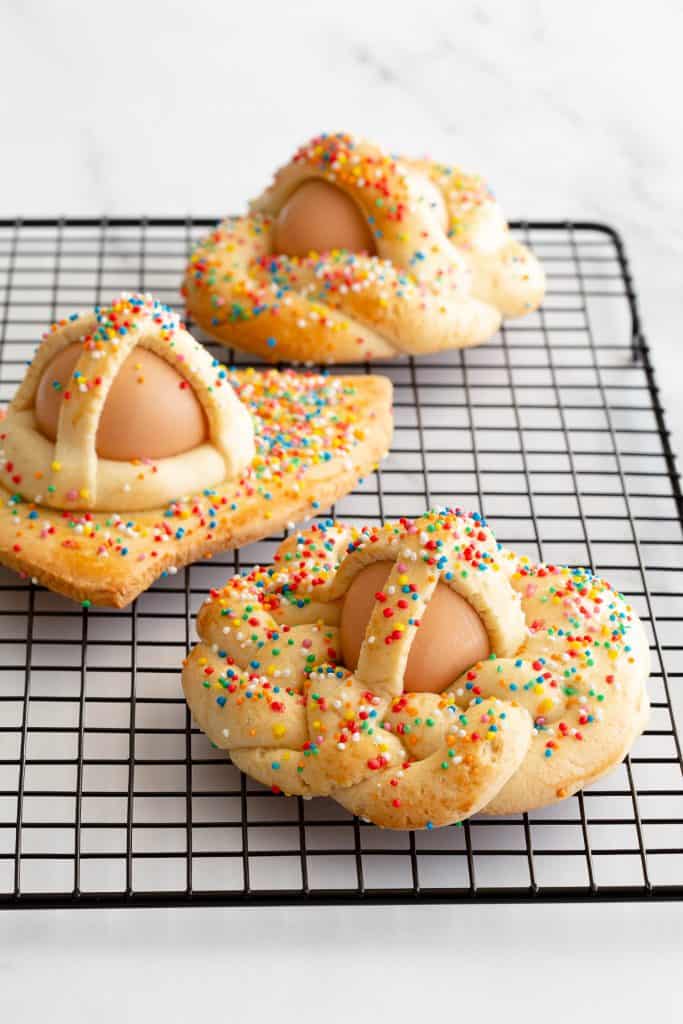
Why We Love This
These cute and colourful Italian Easter cookies are easy to make, while the dough is easy to work with for fun and stress free baking.
You can make cuddura into a wide variety of traditional shapes or get creative and make up your own. Why not start a new Easter tradition and get the kids involved as a fun activity and treat, or give them as edible gifts for Easter?
The freshly baked egg and biscuits combo makes for a great team – a sweet treat with extra nutrients? Yes please! You could even add a hot cappuccino to dunk the cookie in for even more indulgence. This recipe is for a small batch of around 5 cuddura, so if you want to make extras for gifting, feel free to double or triple the recipe.
Related: Galatopita – Greek Milk Pie for Easter / Italian Colomba Cake
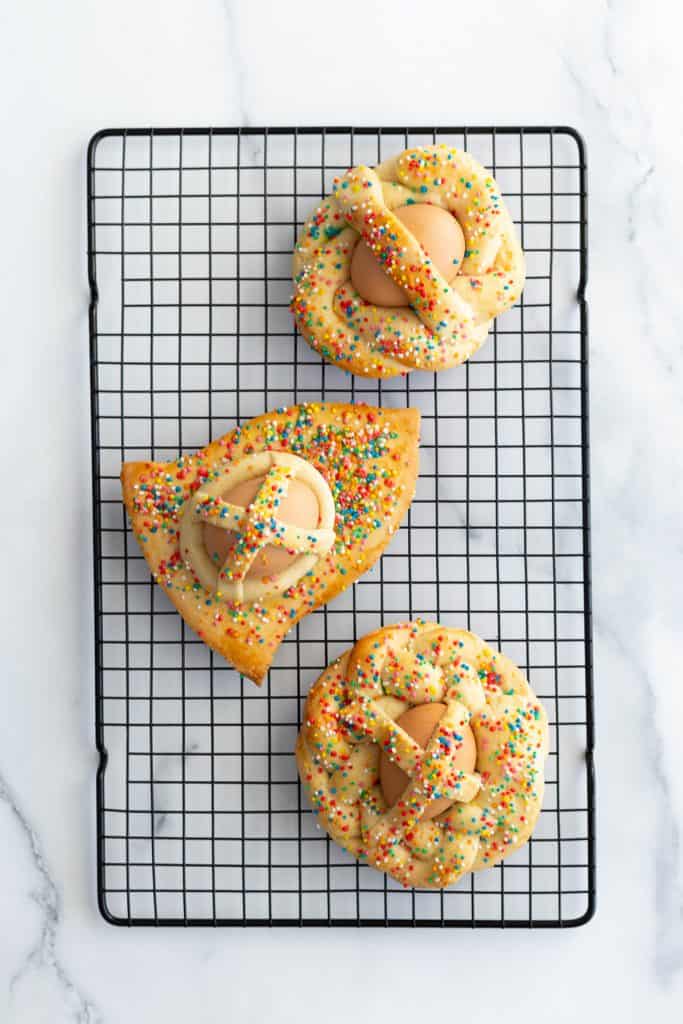
What is Sicilian Cuddura?
Cuddura, sometimes referred to as pupa cu l’ova, are Italian biscuits traditionally made for Easter celebrations and gifting. Sometimes the whole family work together in this treasured Easter ritual to knead the dough, cut out the shapes, then decorate and bake the cuddura.
The cookies consist of a sweet biscuit base with a whole, uncooked egg (in its shell) held in place by dough on top. The egg is a symbol of the resurrection of Christ, and is fully cooked by the time the cuddura have finished baking.
In terms of cuddura shapes, there are lots of variations, each with a different story, wish or religious symbolism. They range from individual doves, ducks, bunnies, baskets, nests, bells or crowns, to bigger woven cookies with enough eggs to suit the family receiving the gift. They’re usually decorated with sprinkles, or sometimes with meringue icing in bright colours.
The Italian word cuddura (plural ‘cudduri’) comes from the Greek word kulloura meaning ‘crown’. They’re said to have originated during the Greek colonisation of Sicily, where they are also known as cannatieddi. They’re quite similar to Koulourakia in terms of base ingredients and shapes, but differ when it comes to presentation and flavourings.
P.S. Love Italian cookies? Try our Italian almond crescent shortbread or chewy Italian almond cookies.
What You’ll Need
Just a handful of everyday pantry staples needed for these oh-so-tasty Italian Easter cookies, including butter, sugar, eggs and flour.
Here’s what else you need to know:
- Flour – Traditionally this recipe calls for all purpose flour with baking powder added. If you prefer using self raising flour instead, go right ahead (if you do, skip the baking powder).
- Eggs – You’ll need some for the dough, some for the baste / egg wash, and some for baking on top of the cookies. If you want to skip the baked eggs on top, feel free. The eggs that are used for decoration don’t need to be hard boiled first, as they will bake in the oven along with the cookies.
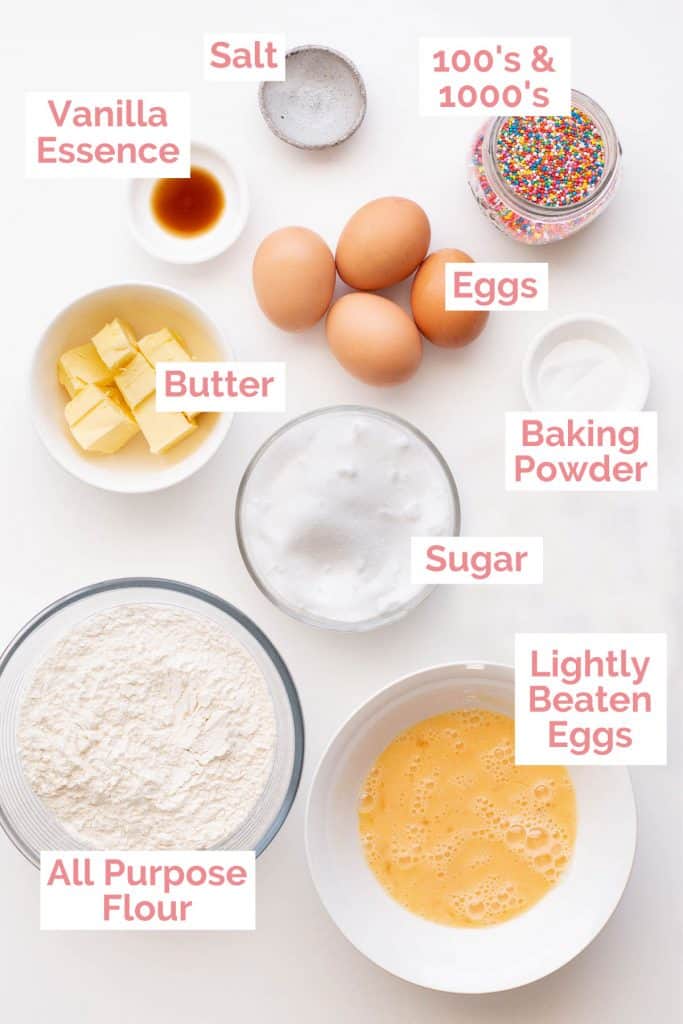
How to make Cuddura:
For the dough:
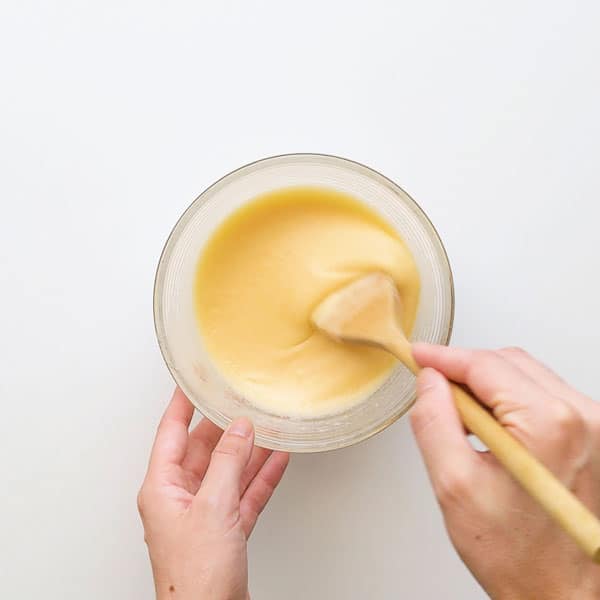
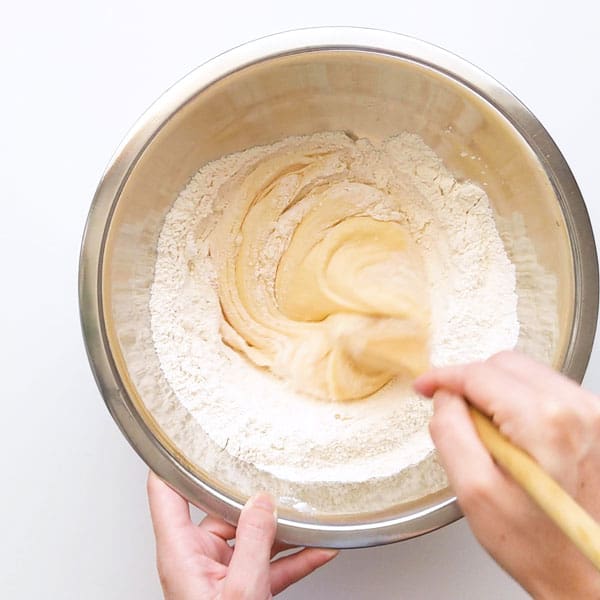
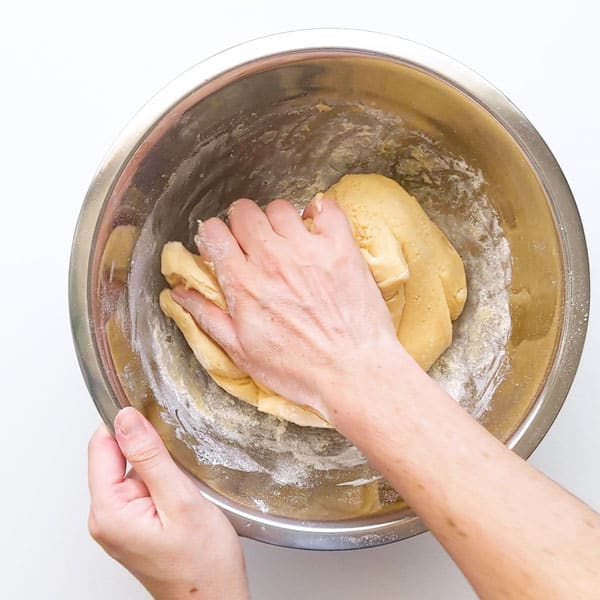
- Pre-heat the oven to 180°C / 350°F. Make an egg wash by mixing the milk and your reserved 1 tbsp of whisked eggs in a small dish.
- Cream together the butter and sugar, mixing for a minute or two. Add in the whisked eggs and vanilla essence, then mix again until combined.
- In a large mixing bowl, add half the flour (2 cups), baking powder and salt. Make a well and add a third of the egg mixture, stirring to incorporate the flour a little at a time. Repeat twice for the remaining two thirds of the egg mixture.
- Once it forms up into a dough, start kneading with your hands. Add in the remaining 2 cups of flour, half a cup at a time. Once all incorporated, the dough shouldn’t be sticking to your hands. If it’s still sticky, add a little more flour to make it easier to form your cuddura.
For the cuddura cookie shapes:
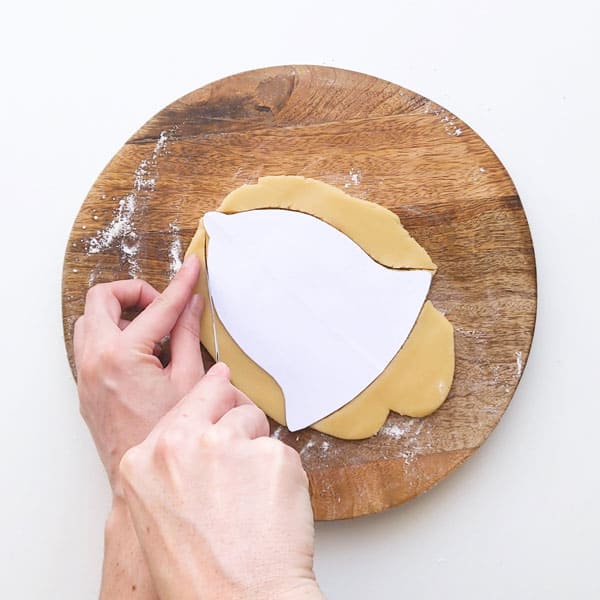
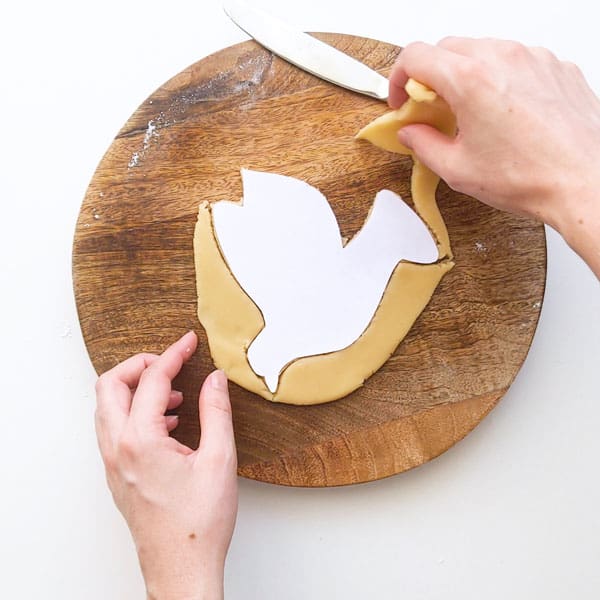

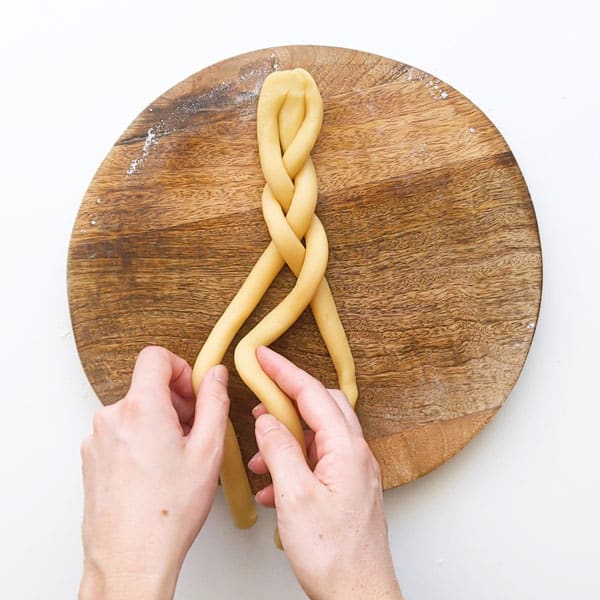

- Form your chosen shapes for each cuddura (see our step-by-step video for the easiest guide to shape each one). Note: Set aside a small portion of dough here to create the strips that will hold your eggs in place.
Shapes can be:
– Bell Shape
– Dove Shape
– Baskets or Nest Shape
– Anything else you want to create!
To finish off the cookies:
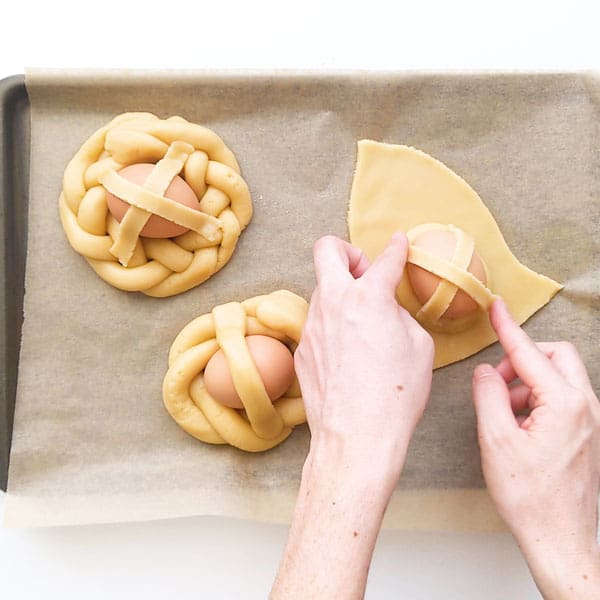
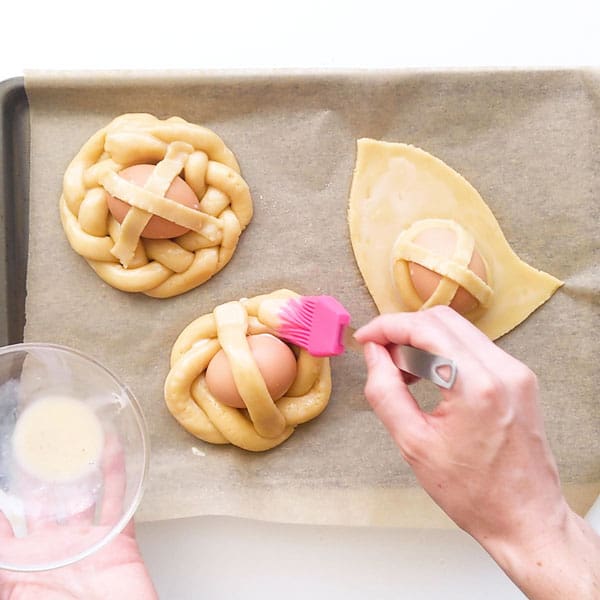
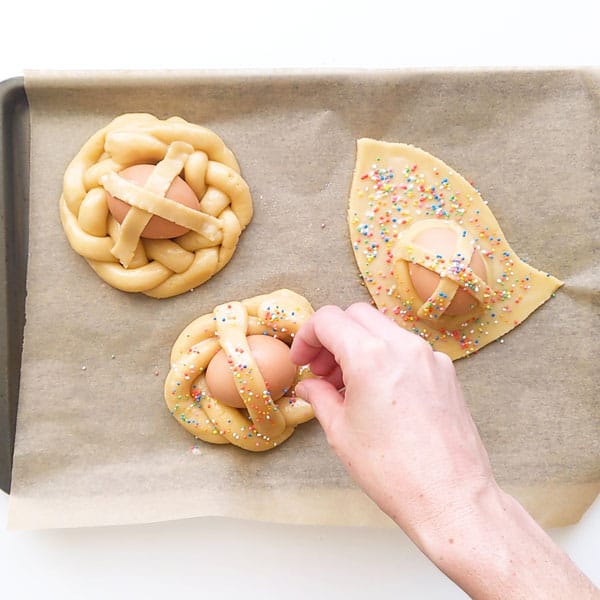
- Once the base shapes are made, top each one with an uncooked egg. Place small single or double strips to hold the eggs on each cuddura. Have fun and get creative here!
- Baste with the egg wash then sprinkle with 100s & 1000s.
- Bake for ~30 minutes or until the edges are light golden brown. Depending on the shapes you chose, some flatter shapes like the dove and bell will cook quicker than the thicker baskets and nests, so put them on a lower rack.
- Remove from the oven and cool on a wire rack. Once cooled, gift within a day, or remove the eggs to store in the fridge separately. Cookies can be stored in an airtight container.
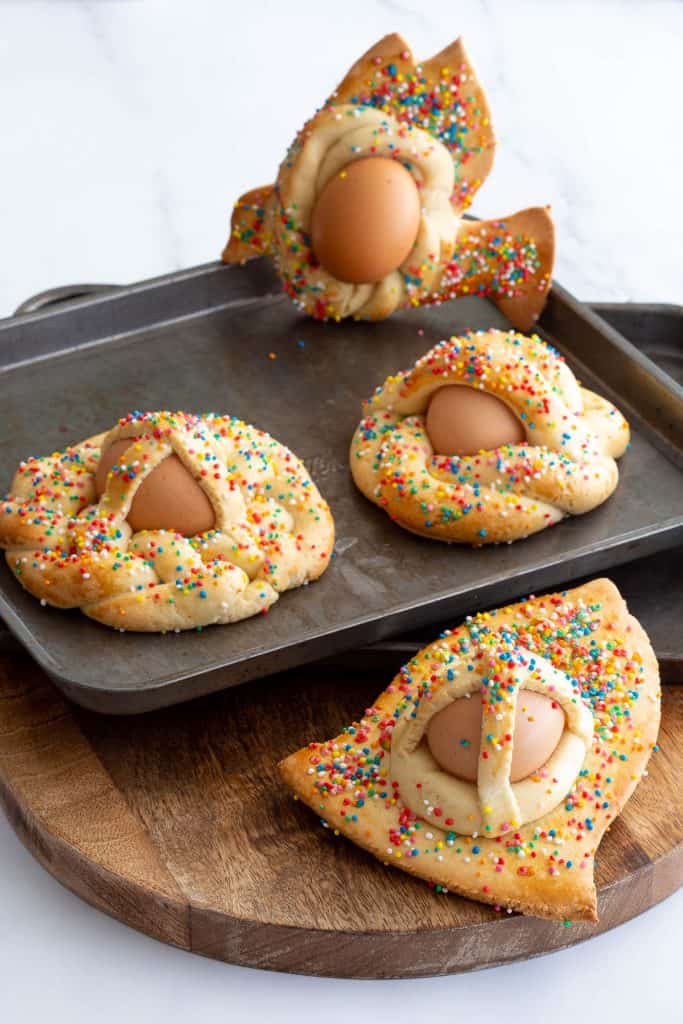
Wandercook’s Tips
- Use Room Temperature Butter – This makes it much easier to work into the dough than cold butter.
- Use Room Temperature Eggs- This makes them cook quicker in the oven.
- Minimise Handling the Dough – If it becomes too warm it will be harder to work with.
- Paper Guides – Trace your chosen shape(s) onto baking paper and cut out. Then press out onto the dough and use a knife to slice out the shape. Peel off the paper and use it for more cookies. If you only have regular paper, make sure to liberally dust the top of your cookie shape with flour to stop it sticking.
- Slicing – Use a pizza slicer to make thin, straight strips.
- Basting – This gives the cookies that beautiful golden brown sheen and helps the sprinkles stick.
- Adjust the Cooking Time – Every oven is different, so keep an eye on the cookies and take them out once they become deliciously golden brown around the edges. Cooking time will also vary depending on the size and thickness of your cookies.
- Extra Flour – Use plenty of flour when rolling out dough and cutting out shapes, this will stop the paper sticking to the dough.
FAQs
They’ll last for around a week if stored in an airtight container. Although let’s face it – freshly baked cookies almost never stick around that long!
Peel it and eat it of course! You could also serve it in a fresh bread roll with salami and cheese, or mash it with a fork and mix it with a little olive oil, salt and lemon juice, with fresh bread for dipping. If you’re not eating right away, just pop it in the fridge for up to 2 days.
Here’s three tips to make sure they cook all the way through: 1. Make sure the eggs are at room temperature, this will help them heat up quicker in the oven. 2. Pre-heat the oven and make sure it’s at 180°C / 350°F before popping the cookies in. 3. Use medium to large eggs, and not extra large.
Variations
- Extra Flavour – Try adding Lemon/orange zest, orange blossom water or vanilla essence into the dough before kneading.
- Extra Toppings – Scatter crystalized sugar, sprinkles / 100s & 1000s or raisins over the top before baking.
- Coloured Easter Eggs – Setup a bowl deep enough to fully submerge the eggs. Fill with boiling water, then add 1 tsp of vinegar and 20 drops of your chosen food colouring. Allow to cool, then soak the uncooked eggs in the solution for around 5 minutes.
- To Ice the Cookies – Skip basting with egg before baking. Once cooled, ice them with regular icing or meringue icing.
- For Decorative Edges – Use a fluted pastry wheel or ravioli wheel, or press gently with a fork the way you would for a pie crust.
- Make into Pocky Sticks – Roll out the dough until it’s about 5mm / 0.2 inches thick. Slice into small strips about 10cm / 4 inches long. Baste with egg wash, top with sprinkles, then bake for 15 minutes. Or skip the egg wash and sprinkles, and coat with melted chocolate once the sticks have cooled completely.
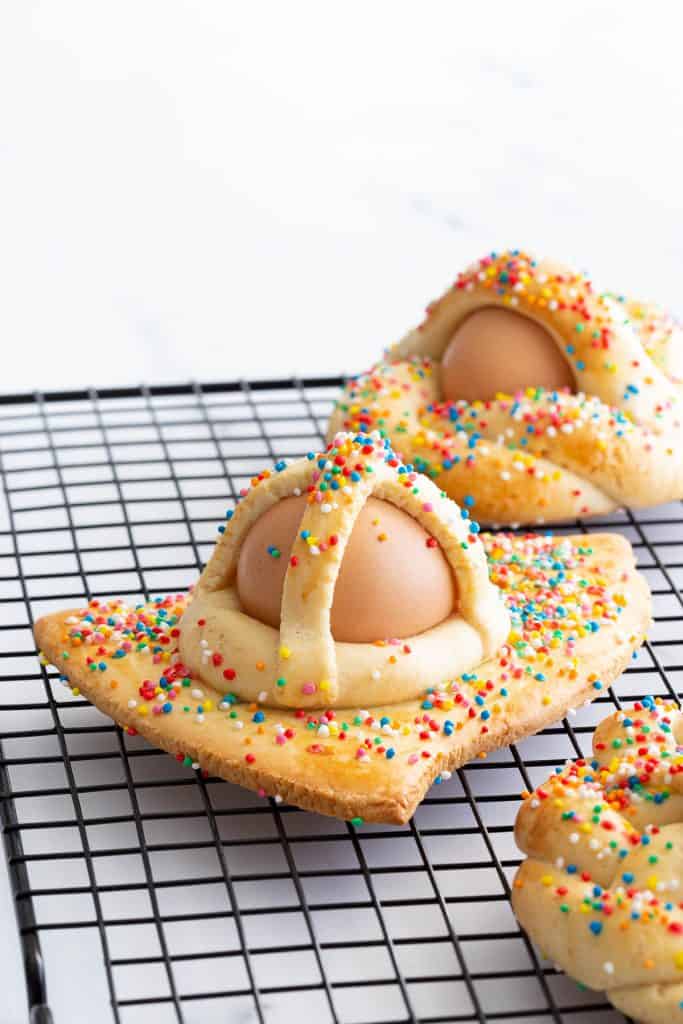
More yummy baked treats to cook next:
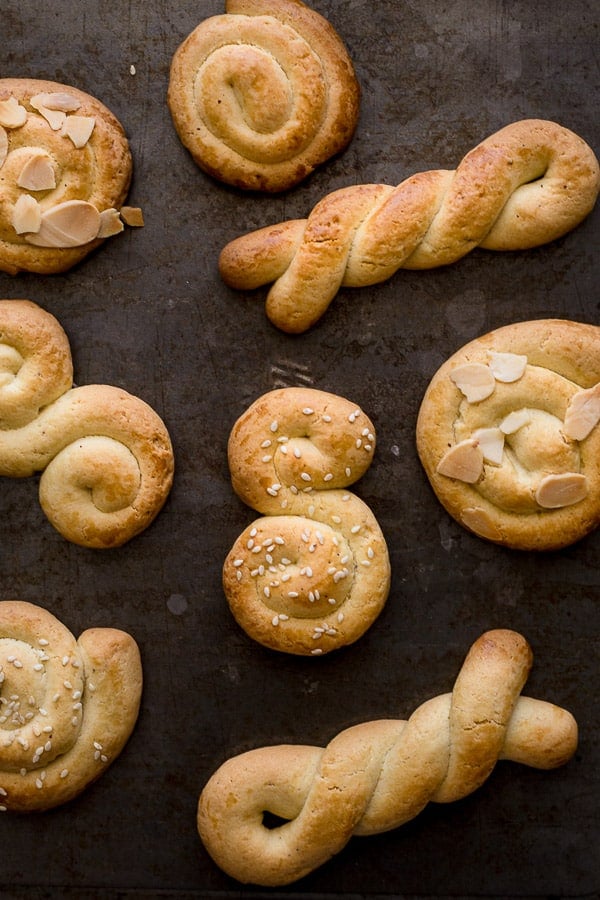
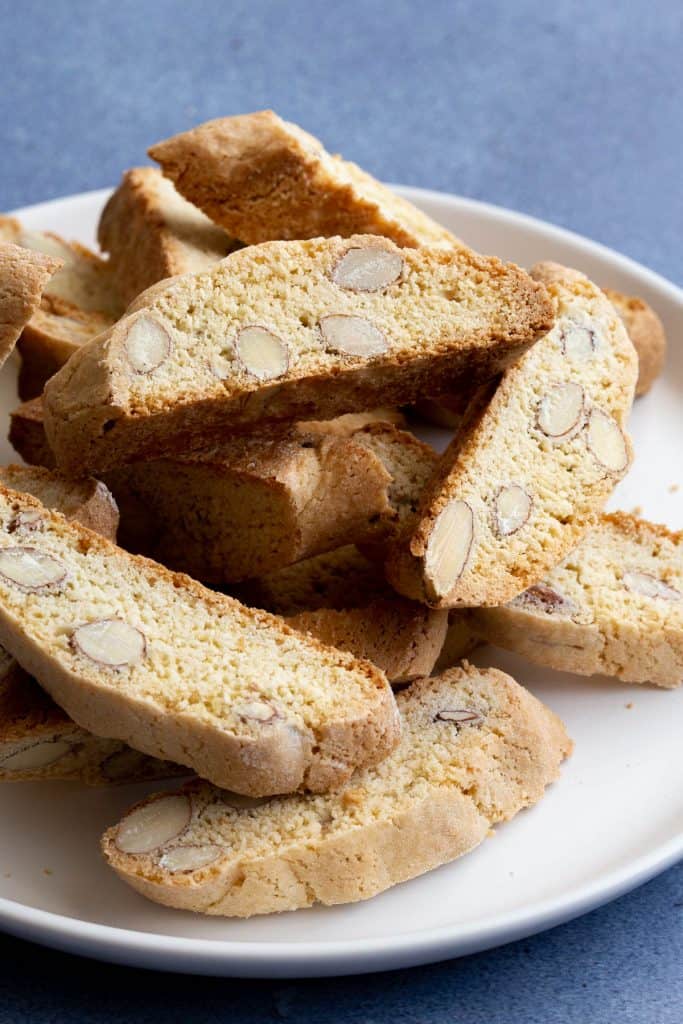
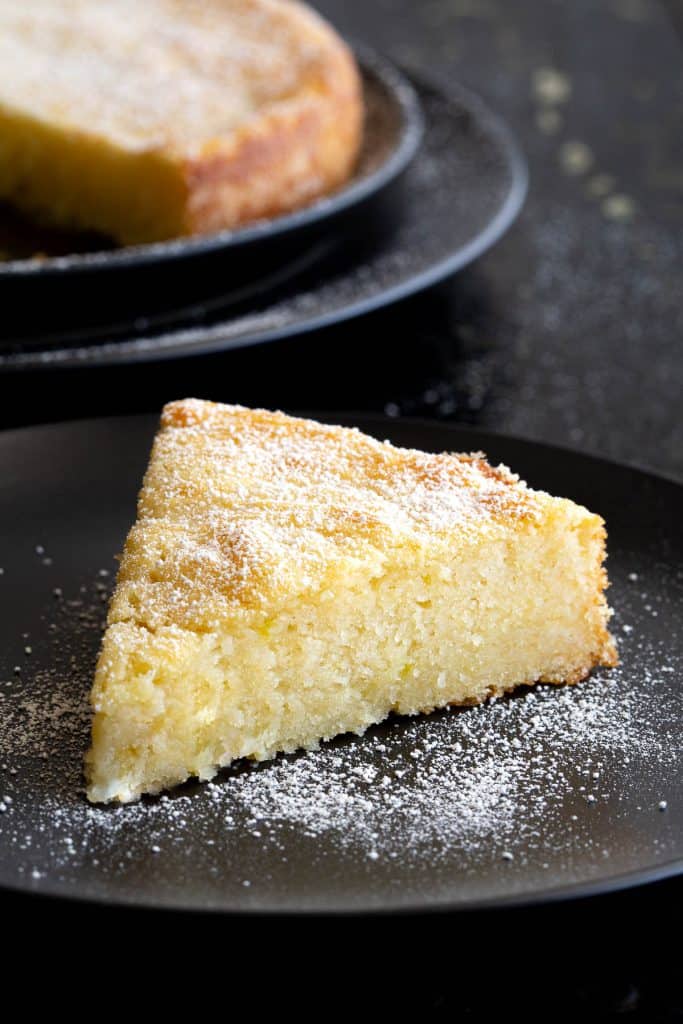
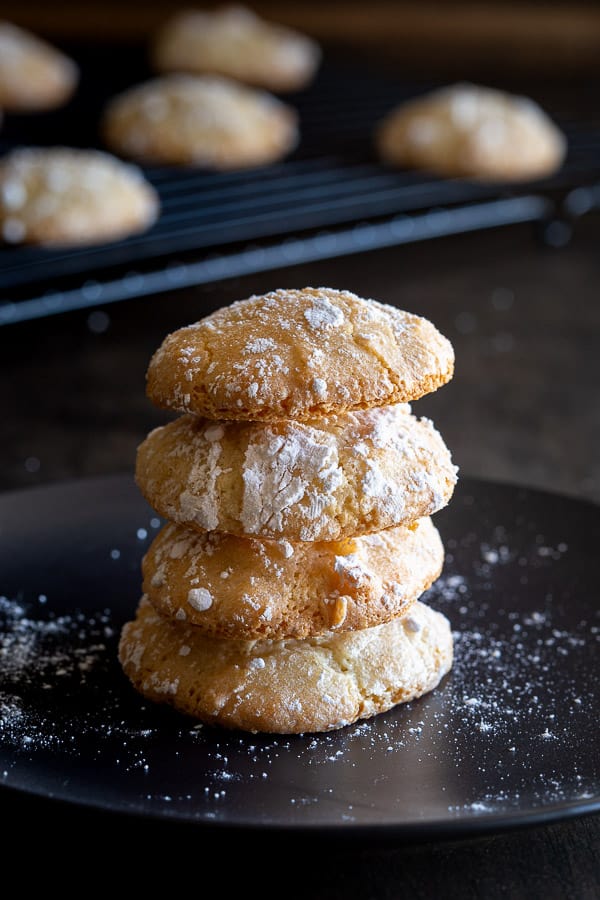
★ Did you make this recipe? Please leave a comment and a star rating below!
Equipment
Ingredients
For the biscuits:
- 1/3 cup butter chopped, 80g / 2.8oz
- 3 eggs lightly beaten, reserve 1 tbsp for basting
- 1 cup sugar 200g / 7oz
- 1.5 tsp vanilla essence
- 4 cups plain flour / all purpose flour 480g / 1 pound + extra for sprinkling surface and rolling pin
- 1.5 tsp baking powder
- 1 tbsp milk for basting
- Pinch salt
To decorate:
- 2 tbsp sprinkles or 100’s & 1000’s
- 5 eggs uncooked, room temperature
Instructions
- Pre-heat the oven to 180°C / 350°F. Make an egg wash by mixing the milk and your reserved 1 tbsp of whisked eggs in a small dish.1 tbsp milk, 3 eggs
- Cream together the butter and sugar, mixing for a minute or two. Add in the whisked eggs and vanilla essence mix again until combined.1/3 cup butter, 3 eggs, 1 cup sugar, 1.5 tsp vanilla essence
- In a large mixing bowl, add half the flour (2 cups), baking powder and salt. Make a well and add a third of the egg mixture, stirring to incorporate the flour a little at a time. Repeat twice for the remaining two thirds of the egg mixture.4 cups plain flour / all purpose flour, 1.5 tsp baking powder, Pinch salt
- Once it forms up into a dough, start kneading with your hands. Add in the remaining 2 cups of flour, half a cup at a time. Once all incorporated, the dough shouldn't be sticking to your hands. If it's still sticky, add a little more flour to make it easier to form your cuddura.4 cups plain flour / all purpose flour
- Form your chosen shapes for each cuddura (see our making cuddura shapes section above or our step-by-step video for the easiest guide to shape each one). Note: Set aside a small portion of dough here to create the strips that will hold your eggs in place. Shapes can be:– Bell Shape– Dove Shape– Baskets or Nest Shape– Anything else you want to create!
- Once the base shapes are made, top each one with an uncooked egg. Place small single or double strips to hold the eggs on each cuddura. Have fun and get creative here!5 eggs
- Baste with the egg wash then sprinkle with 100s & 1000s.2 tbsp sprinkles or 100’s & 1000’s
- Pop in the oven and bake for around 30 minutes or until the edges are light golden brown. Depending on the shapes you chose, some flatter shapes like the dove and bell will cook quicker than the thicker baskets and nests, so put them on a lower rack.
- Remove from the oven and cool on a wire rack. Once cooled, gift within a day, or remove the eggs to store in the fridge separately. Cookies can be stored in an airtight container.
Video
Recipe Notes
- Flour – Traditionally this recipe calls for all purpose flour with baking powder added. If you prefer using self raising flour instead, go right ahead (if you do, skip the baking powder).
- Eggs – You’ll need some for the dough, some for the baste / egg wash, and some for baking on top of the cookies. If you want to skip the baked eggs on top, feel free. The eggs that are used for decoration don’t need to be hard boiled first, as they will bake in the oven along with the cookies. Use room temperature eggs, this makes them cook quicker in the oven.
- Use Room Temperature Butter – This makes it much easier to work into the dough than cold butter.
- Minimise Handling the Dough – If it becomes too warm it will be harder to work with.
- Paper Guides – Trace your chosen shape(s) onto baking paper and cut out. Then press out onto the dough and use a knife to slice out the shape. Peel off the paper and use it for more cookies. If you only have regular paper, make sure to liberally dust the top of your cookie shape with flour to stop it sticking.
- Slicing – Use a pizza slicer to make thin, straight strips.
- Basting – This gives the cookies that beautiful golden brown sheen and helps the sprinkles stick.
- Adjust the Cooking Time – Every oven is different, so keep an eye on the cookies and take them out once they become deliciously golden brown around the edges. Cooking time will also vary depending on the size and thickness of your cookies.
- Extra Flavour – Try adding Lemon/orange zest, orange blossom water or vanilla essence into the dough before kneading.
- Extra Toppings – Scatter crystalized sugar, sprinkles / 100s & 1000s or raisins over the top before baking.
- Coloured Easter Eggs – Setup a bowl deep enough to fully submerge the eggs. Fill with boiling water, then add 1 tsp of vinegar and 20 drops of your chosen food colouring. Allow to cool, then soak the uncooked eggs in the solution for around 5 minutes.
- To Ice the Cookies – Skip basting with egg before baking. Once cooled, ice them with regular icing or meringue icing.
- For Decorative Edges – Use a fluted pastry wheel or ravioli wheel, or press gently with a fork the way you would for a pie crust.
- Make Into Pocky Sticks – Roll out the dough until it’s about 5mm / 0.2 inches thick. Slice into small strips about 10cm / 4 inches long. Baste with egg wash, top with sprinkles, then bake for 15 minutes. Or skip the egg wash and sprinkles, and coat with melted chocolate once the sticks have cooled completely.
Nutrition
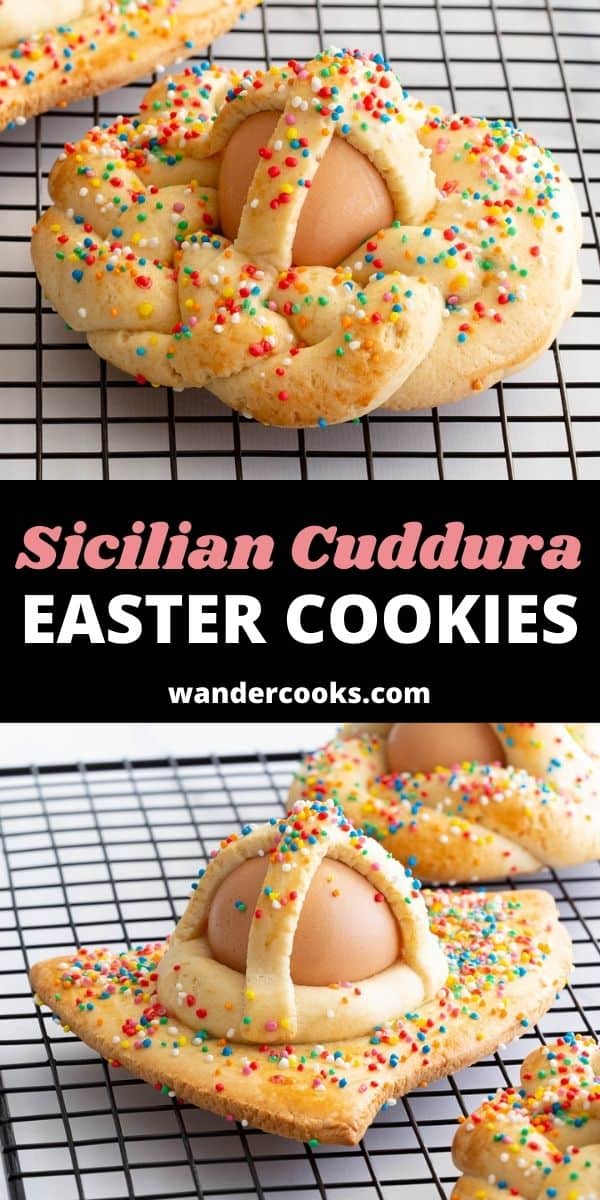

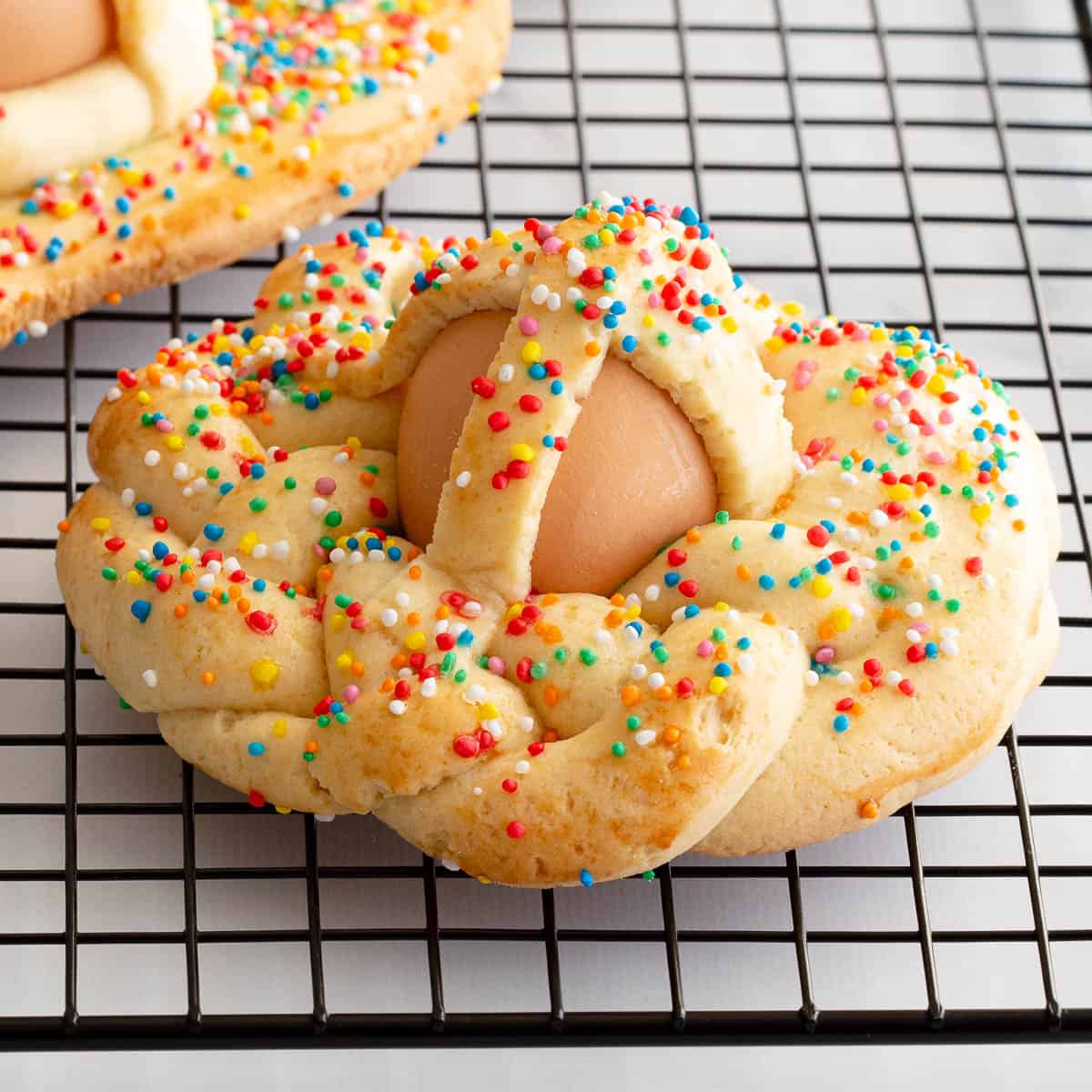



12 Comments
Jackie
18/04/2022 at 6:00 amI’ve never heard of adding sprinkles or decorative sugar before baking?
Wandercooks
19/04/2022 at 1:48 pmHi Jackie, we put the sprinkles on before baking so they stick to the cookies. If you tried to put them on after they’d probably just roll off. 🙂
Gilda Briguglio
15/04/2022 at 9:54 amHi I was just wondering if the dough can be made the night before?
Wandercooks
19/04/2022 at 1:52 pmHey Gilda, we haven’t personally tested this but you should be fine to make the dough the night before. Just make sure to rest it on the bench around 30 mins before you want to form it up into the cookie shapes to help it come up to temperature and make it easier to work with.
Sydney
05/04/2021 at 11:48 amYou mention the egg mixture twice in this recipe but the ingredient list only includes three eggs whisked. When do I add the mixture? How much? Half for the butter and sugar, half for the flour? This is so confusing. 😥
Wandercooks
05/04/2021 at 12:10 pmHey Sydney! Yes, we mentioned it twice. You need to reserve 1 tbsp of the egg mixture to make your egg wash with the milk in Step 1 of the recipe. The remainder is then mixed in after you’ve creamed the butter and sugar in Step 2. The egg wash is just to give the cookies the shiny finish, and if you’ve already added all your egg mixture in, that’s totally fine – just use milk only for your wash. Hope this helps and have fun baking!
Jean
03/04/2021 at 5:03 amThey look fine after baking. I had a terrible time with the dough, it was sticky then crumbly. I added another egg and a little oil. They were hard to roll into tubes to make the baskets. I do not know what I did wrong?
Wandercooks
03/04/2021 at 7:34 amHi Jean! Glad they turned out okay in the end. It sounds like you may have needed a little sprinkle of extra flour in the beginning, then added too much. Once the dough is all incorporated and you’ve needed it in well, if it is sticking to your hands, start with a little sprinkle at a time until the dough becomes tacky to the touch but is no longer sticking to your hand. I hope this helps for next time, and Happy Easter!
Wei-Yann Chen
02/04/2021 at 2:03 pmHi Laura and Sarah, I just made this today, on Good Friday! Also the day my first born popped up 6 years ago hehe. It is so delicious and the dough was most forgiving, I was afraid it might get too soft in this humid Malaysian weather but it held up just fine. We made some into pocky sticks too! Thank you so much for the clear instructions and lovely photos, it is a treat browsing through your wonderful food blog 😁
Wandercooks
02/04/2021 at 3:03 pmHey Wei-Yann, thank you so much for your feedback, this made us so happy to hear! How wonderful to make these today, and happy birthday to your first born as well. 🙂 Love your idea for the pocky sticks with leftovers, we’ll have to add this on as a tip. Happy Easter!
Angela
31/03/2021 at 8:49 amMy daughter made these and the egg did not cook any idea why it did not cook.
Wandercooks
31/03/2021 at 10:17 amHey Angela! Hope she enjoyed making all the shapes. 🙂 Thanks for reaching out and great question. There could be a few reasons, so I’ll add in a section on this to the recipe as well. 1. Make sure the eggs are at room temperature, this will help them heat up quicker in the oven. 2. Pre-heat the oven and make sure it’s at 180°C / 350°F before popping the cookies in. 3. Use medium to large eggs, and not extra large. This can also help them to cook quicker. Hope this helps!